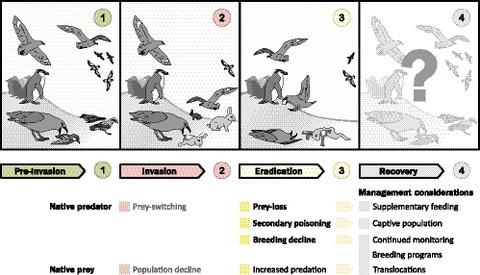当前位置:
X-MOL 学术
›
J. Appl. Ecol.
›
论文详情
Our official English website, www.x-mol.net, welcomes your
feedback! (Note: you will need to create a separate account there.)
Bottom‐up effect of eradications: The unintended consequences for top‐order predators when eradicating invasive prey
Journal of Applied Ecology ( IF 5.0 ) Pub Date : 2020-12-24 , DOI: 10.1111/1365-2664.13828 Toby Travers 1 , Mary‐Anne Lea 1 , Rachael Alderman 2 , Aleks Terauds 3 , Justine Shaw 4
中文翻译:

根除的自下而上的影响:消除入侵性猎物对顶级捕食者的意外后果
更新日期:2020-12-24
Journal of Applied Ecology ( IF 5.0 ) Pub Date : 2020-12-24 , DOI: 10.1111/1365-2664.13828 Toby Travers 1 , Mary‐Anne Lea 1 , Rachael Alderman 2 , Aleks Terauds 3 , Justine Shaw 4
Affiliation

|
- The eradication of invasive species from islands yields significant conservation returns. However, novel challenges continue to arise as projects expand in their scope, complexity and scale. Prey‐loss and secondary poisoning were historically considered to have limited impact on native top‐order predators when planning eradications, but this has rarely been tested quantitatively.
- We used a 10‐year timeseries of Brown Skua Stercorarius antarcticus lonnbergi breeding surveys and isotopic dietary analysis on Macquarie Island to investigate how prey‐loss and secondary poisoning deaths resulting from the eradication of an abundant invasive prey species, European rabbits Oryctolagus cuniculus, affected a top‐order predator.
- Skua nest density declined from 7.14 nests/km2 (95% CI: 6.01–8.27) in the presence of rabbits (pre‐eradication) to 3.73 nests/km2 (95% CI: 2.96–4.51) in the first 3 years after the eradication of rabbits, before showing signs of recovery in the 4 years thereafter. However, breeding success dropped from 1.01 chicks/nest (95% CI: 0.76–1.26) to as low as 0.38 chicks/nest (95% CI: 0.23–0.53) with little evidence of recovery.
- Secondary poisoning affected a greater number of skuas than anticipated prior to the eradication, including skuas nesting in areas where rabbits were not typically hunted as prey. We highlight that invasive prey often replace native prey in the diet of native predators rather than provide an additional source of food, and rapid eradication of non‐native prey can have long‐term impacts for predators, particularly when recovery of native prey is slow.
- Synthesis and applications. Monitoring programmes that complement large‐scale eradication projects and address (a) trophic‐driven declines in predator populations and (b) population‐level impacts of secondary poisoning are integral to ensuring bottom‐up effects of eradications are anticipated and adequately quantified. If prey deficits caused by eradication of invasive prey are expected to be severe but short‐lived, supplementary feeding programmes may buffer against increased predation pressure on native prey and reduced breeding success of native predators. Alternatively, if the rapid recovery of native prey is not expected to occur naturally, breeding programmes and translocation of native prey prior to assist recovery of native predators should be considered to support ecosystem restoration.
中文翻译:

根除的自下而上的影响:消除入侵性猎物对顶级捕食者的意外后果
- 消除岛屿上的入侵物种产生了巨大的保护回报。但是,随着项目范围,复杂性和规模的扩大,新颖的挑战继续出现。从历史上看,在规划消灭工作时,猎物损失和继发中毒对本地顶级捕食者的影响有限,但很少进行定量测试。
- 我们使用了10年时间序列的布朗贼鸥(Stevencorarius antarcticus lonnbergi)繁殖调查和麦格理岛(Macquarie Island)的同位素饮食分析,调查了由于消除了丰富的入侵猎物物种欧洲兔子穴兔(Oryctolagus cuniculus)而导致的猎物损失和继发中毒死亡的情况,顶级捕食者。
- 在有兔子(根除前)的情况下,贼鸥的巢密度从7.14个巢/ km 2(95%CI:6.01-8.27)下降到在之后的头三年中的3.73个巢/ km 2(95%CI:2.96-4.51)。消灭家兔,然后在随后的4年中显示出恢复的迹象。然而,育种成功率从每只巢雏1.01羽(95%CI:0.76-1.26)下降到每只巢雏0.38羽(95%CI:0.23-0.53),几乎没有恢复的迹象。
- 继发性中毒影响的怪数量比根除之前预期的要多,包括在通常不捕猎兔子的地区筑巢的ku怪。我们强调指出,侵入性猎物通常会代替天然捕食者的饮食来代替天然猎物,而不是提供额外的食物来源,而且迅速消灭非本地猎物会对捕食者产生长期影响,尤其是当本地猎物的恢复速度较慢时。
- 综合与应用。监测计划补充了大规模的根除项目,并解决了(a)由营养引起的捕食者数量下降和(b)二次中毒对人口水平的影响,这对于确保预期并充分量化根除的自下而上的影响是不可或缺的。如果预计由于消除侵入性猎物而造成的猎物短缺将是严重的,但却是短暂的,那么补充饲养计划可能会缓解捕食对当地猎物造成的压力增加和减少本地捕食者繁殖成功的问题。或者,如果预计自然不会迅速恢复本地猎物,则应考虑在协助恢复本地掠食者之前进行繁殖计划和将本地猎物转移,以支持生态系统的恢复。











































 京公网安备 11010802027423号
京公网安备 11010802027423号